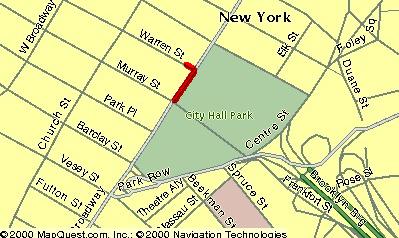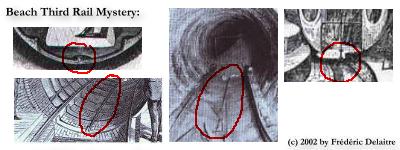Last modified: 02/02/01
Back in 1870 just beneath the Great White Way
Alfred Beach worked secretly
Risking all to ride a dream
His wind-machine
His wind-machine
Sub-Rosa Subway
(John Woloschuk / Dino Tome)
Location:
Under Broadway, from the corner of Warren Street/Broadway to Murray Street, New York City, New York, USA. Entrance for public
was located at 260, Broadway.

Timespan:
1870 - 1873
Description:
First subway of New York City. It had a single station located in the basement of the house
located at the corner of Warren Street and Broadway. Passenger were carried in a car pushed forward
by the pneumatic pressure generated by a huge fan. At the end of the tunnel, near Murray Street,
the car stopped. The rotation of the fan was reversed and the car was "sucked" back to Warren Street
station.
This subway was designed for experimental and promotional purposes. Alfred E. Beach intended to build a full scale network of pneumatic lines for public transportation in the already crowded Manhattan downtown.
The Beach Pneumatic Subway was very similar to the
Crystal Palace Pneumatic Railway, tested a few years before in England.
Car departure at Warren Street station
Beach Subway tunnel portal was featured in Ivan Reitman's film "Ghostbusters II" (1989) in the slime river sequence.
"Walking up Broadway in one of the hottest of last summer's hot days, at the corner of Warren Street, arose a most unaccountable but altogether delightful breeze. Roasted newsboys stood still for a moment, and lifted the remnants of what were once hats and caps, to enjoy it. Perspiring men and parboiled women paused and drew long breaths of enjoyment, and one old gentleman, whose light straw hat suddenly swept upward, borne by a stronger gust than usual, gazed after it placidly, but made no movement of pursuit.
"What is it?" I asked; and the doctor answered, "Come and see."
Down we went into a basement, where we faced at once, the greatest blower ever yet seen on this continent. Not, however, a New York politician, as you may have supposed, but a rotary blower, the use of which you shall soon learn.
For this paddle-box affair, with its pretilly frescoed wood-work, means that the days of dusty horse cars and rumbling omnibusses are almost at an end, and that the millennium of horses may begin in our own time. This blower or, ťolor, is the motive power, which will some day send you in less than a minute from the Battery to the Central Park, and the tunnel through which you will be shot, twelve feed under ground, is already several hundred feet in length.
Originally, the intention was simply to blow packages and mail matter through a pneumatic tube, and the Legislature gave the right to construct such a tube. Once at work, the projectors of the sceme discovered it would cost little more to make it a passenger tube and blow people as well as packages, and another application has been made to Legislature for permission to increase the size of the tunnel.
But now you will want, as I did, to see how the boring was done. An entrance having been made from the surface in Warren Street, deep enough to escape sewers, gas and water pipes, an enormous cylinder was introduced, open at both ends, and at the front end an arrangement of shelves, to receive the earth bored out, and keep it from too rapidly filling up the shield. At the rear end were arranged eighteen hydraulic rams, all connected with a single water pump. From the rear of the shield, and passing completely around it, extends a band or hoop of sheet steel, two feet wide, and an eighth of an inch thick, called the "hood."
Inside this hood is built a section of the brick work of the tunnel, and when sixteen inches in length are laid, the pump is put in motion, and the rams push the cylinder which great force into the earth, which, pressing between the shelves, falls to the bottom of the shield, and is taken away in barrows and cars. When it has gone on sixteen inches, the motion is stopped and a new section of brick-work made, which in turn is pushed forward into place, and in this way, nearly eight feet a day can be tunnelled and bricked.
Having seen the end of the tunnel, you can better understand the beginning, and are ready now to go back, as we did, and look into the depot, directly under the sidewalk of Warren Street, and reached by a long hall, which is entered in turn by a flight of steps from Broadway. The depot office, a large room forty-five feet long and twelve feet wide, comes first, and is completed and fitted up in every way like a first-class business man's office. Then comes the main saloon, one hundred and twenty feet by fourteen; pictures on the walls, a fountain, and flowers, a grand piano and expensive clock. At the east end of the room, a few steps descend to the railway-platform, by which stands the pneumatic passenger car. This is curcular, of course, with floor of oiled wood, and handsomely upholstered seats for twenty persons. The car is lighted by oxy-hydrogen gas, and the waiting-rooms in the same way.
Taking your seat, and the doors at both ends being closed, the engineer or conductor touches a telegraph wire on the wall of the tunnel, and in a moment the car is in motion, but so gently that you hardly believe it, till, opening the door, the conductor calls, "Murray Street!" and in another moment you are back to the original starting point at Warren Street. And what has done it? Neither steam nor horses, but air alone. Two powerful steam engines force air into the ťolor or blower, which is made to take the place of the old-fashioned leather bellows, and which sends or can send a perfect tornado of air through the tunnel. This blast of air, graduated at will, pushes the car forward at a rate of from two to sixty miles an hour. The car is so arranged that by pressing a brake a signal is telegraphed to the operator in the engine room, who, by shifting a valve, changes the current from a blowing in to a suction one, which draws out as fast as it before sent in. So you can ride back and forth, growing more and more delighted with the clean, dry, quiet tunnel, and the pure, fresh air of the car. A deep, rumbling noise from the wagons and carts overhead is the only reminder of the outward world. Snow and dust, heat and cold find no kingdom here. Warm in summer and cool in winter, the tunnel is and will be as even in temperature as the Mammoth Cave, and the weary man or woman who spends hours daily in getting to and from business may, when that joyful day of a completed underground railroad comes, allow five minutes for going five miles, and sleep in peace till seven in the dark winter mornings, or ride and walk in the bright summer ones.
So the world goes on, doing more and more wonderful things every day, and who knows but that before you Youth's Companion readers are old men and women, you and I together may go down to the rooms of the "Boston, New York and Liverpool Transit Company," and in a twinkling find ourselves in England? Who knows? "


© 1998-2002 by Frédéric Delaitre
Created: 01/05/06
Last modified: 02/02/01
